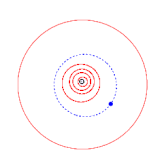(9973) Szpilman
|
Asteroid (9973) Szpilman |
|
|---|---|

|
|
| Orbit of (9973) Szpilman | |
| Properties of the orbit ( animation ) | |
| Orbit type | Middle main belt asteroid |
| Major semi-axis | 2.5311 AU |
| eccentricity | 0.1717 |
| Perihelion - aphelion | 2.0966 AU - 2.9656 AU |
| Inclination of the orbit plane | 1.4938 ° |
| Length of the ascending node | 296.97373 ° |
| Argument of the periapsis | 104.6547 ° |
| Time of passage of the perihelion | 13th September 2018 |
| Sidereal period | 4.03 a |
| Mean orbital velocity | 18.72 km / s |
| Physical Properties | |
| Absolute brightness | 14.3 mag |
| history | |
| Explorer | Eric Walter Elst |
| Date of discovery | July 12, 1993 |
| Another name | 1993 NB 2 , 1949 QJ, 1979 BV 2 , 1991 AM 3 |
| Source: Unless otherwise stated, the data comes from JPL Small-Body Database Browser . The affiliation to an asteroid family is automatically determined from the AstDyS-2 database . Please also note the note on asteroid items. | |
(9973) Szpilman is an asteroid of the main central belt , which was discovered on July 12, 1993 by the Belgian astronomer Eric Walter Elst at the La Silla Observatory of the European Southern Observatory in Chile ( IAU code 809). There had already been several sightings of the asteroid: in August 1949 under the provisional designation 1949 QJ at the State Observatory Heidelberg-Königstuhl , on January 27 and 29, 1979 (1979 BV 2 ) at the Palomar Observatory in California and on January 9 , 1979 . and January 16, 1991 (1991 AM 3 ) at the Karl Schwarzschild Observatory in the Tautenburger Forest .
(9973) Szpilman was named on June 14, 2003 after the Polish pianist Władysław Szpilman (1911–2000), who survived the Warsaw Ghetto .
See also
Web links
- (9973) Szpilman in the database of the "Asteroids - Dynamic Site" (AstDyS-2, English).
- (9973) Szpilman in the Small-Body Database of the Jet Propulsion Laboratory of NASA at the California Institute of Technology (Caltech) in Pasadena , California (English)
- Discovery Circumstances by (9973) Szpilman according to the Minor Planet Center of the International Astronomical Union at the Harvard-Smithsonian Center for Astrophysics in Cambridge , Massachusetts (English)
Individual evidence
- ↑ Observations by (9973) Szpilman on minorplanetcenter.net (English)